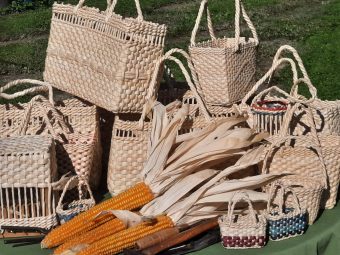Natural materials have long inspired people, and with growing environmental awareness, we increasingly strive to utilize them in diverse and purposeful ways. Corn husks are one such material, most commonly used as livestock feed or compost for eco-friendly fertilizer. Yet, their usefulness does not end there. This story reveals how corn husks can be used innovatively and unexpectedly.
Winter is the season most often dedicated to weaving baskets, providing the ideal time for this process. During the colder months, women have more time to focus on weaving, preparing the husks, and dyeing them, creating beautiful and durable handcrafted bags. These corn-husk bags, originally from Međimurje, Croatia, have even made their way to Dubai.
Several women from the Women’s Association of Nedelišće are on a mission to bring tradition into the modern age. Dušanka Medved, president of the Association, shared with Energetski Portal Magazine the details of how these bags are made, how long they last, and much more.

Preparation begins in the autumn during the corn harvest, when supplies of husks are replenished. In Međimurje, the husks are also referred to as luščije, and they are usually prepared two years in advance, since the next harvest is never guaranteed and the basket-weaving season must always be ready.
“After collection, the corn husks are dried for two to three days before being prepared. We need a wooden mold, small nails, and pliers for weaving. First, we weave the base structure made of strips, followed by the basket body. Then the edges are trimmed, and finally, the handles are woven. The completed bag is left to dry in a warm place for two days before it’s removed from the mold. The finished baskets are then placed in sulfur,” says our interviewee.
She notes that it’s essential to soak and drain the husks properly before weaving, as otherwise they could break during the process. Sulfur is used to eliminate harmful organisms and prolong the basket’s durability while acting as a natural bleaching agent. Fabric dyes are used for dyeing: the water is brought to a boil, the dye is added along with the damp husks, and the process continues for about two hours to allow the color to penetrate deeply into the fibers. Afterward, the husks are thoroughly rinsed to avoid staining hands or clothing.
IN FOCUS:
- When Food Waste Becomes a Resource
- Smart Energy Innovation From the Turbine Tech Team
- A Vision that Transforms the Recycling Industry
A Fusion of Tradition and Ecology
These fashion items are made entirely from natural materials—no glue is involved. Each basket requires about five kilograms of corn husks. Flowers, made either from the husks themselves or from fabric, can be added during the weaving process.
Our interviewee also shares that finding quality corn husks is increasingly complex because traditional corn varieties are rarely grown. Hybrid corn has shorter ears and leaves, which break easily and are not as soft or as suitable as the older varieties. Additionally, it must be harvested by hand, which is now less common.
The women of the Nedelišće Association craft baskets in various sizes and shapes—from the smallest to the largest, square to round. A basket can last up to 15 years if kept dry and protected from moisture. If it gets wet, it should be air-dried.
There is interest in this craft, though some try and give up. They’ve trained children in primary and secondary schools and even held a workshop at a museum. They were surprised to find that boys showed more interest than girls.
Their goal is not just to sell baskets, but also to demonstrate the making process, so they always bring their tools along.
Last year, they held a basket festival and sold every last piece. The skill of crafting utilitarian items from corn husks in the Međimurje region has become the eighteenth element of intangible cultural heritage in this area, officially listed in the Register of Cultural Goods of the Republic of Croatia with permanent protection status.
Prepared by Jasna Dragojević
Read the story in the new issue of the Energy portal Magazine SUSTAINABLE MOBILITY
